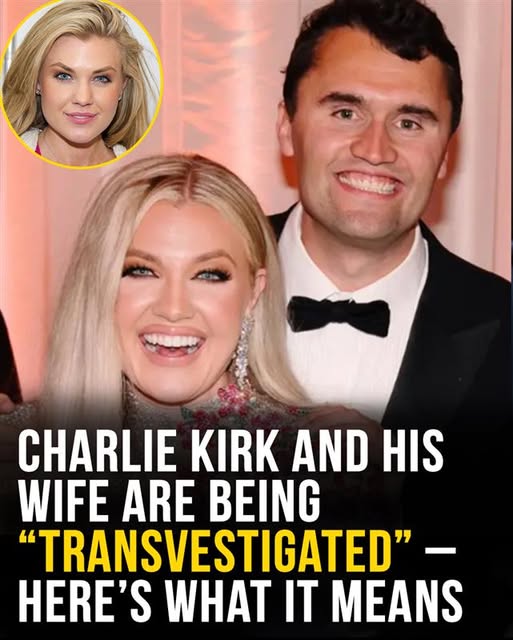When news about the late political commentator Charlie Kirk reached national headlines earlier this year, the public conversation quickly expanded beyond the immediate circumstances of his passing.
In the weeks that followed, a wave of misinformation and speculation emerged online — and now, a newer and particularly harmful trend has pulled both him and his wife, Erika Kirk, into its spotlight.
The term attached to this latest rumor is “transvestigating,” a word many people have never encountered before. It may sound unfamiliar, but its influence has grown steadily across social platforms, especially in corners of the internet that thrive on conspiratorial claims.
Before understanding how Erika Kirk became the newest target, it’s important to understand what this online trend actually is.
What “Transvestigating” Means
The term refers to an online conspiracy movement in which individuals claim — without evidence — that various public figures are secretly transgender. Rather than relying on facts, these claims hinge on speculation about a person’s appearance, often framed using outdated stereotypes about body shape or facial features.
Over the years, well-known entertainers, athletes, and political figures have been pulled into these baseless accusations. Public examples have included Michelle Obama, Serena Williams, Lady Gaga, and Beyoncé — all targeted not because of anything they said or did, but because conspiracy groups thrive on controversy and visibility.
These claims have consistently been disproven and widely criticized for being invasive, discriminatory, and rooted in misinformation.
Unfortunately, Erika Kirk is now facing a similar wave of unfounded attention.
Why Erika Kirk Became a Target
Following Charlie Kirk’s passing, his wife, Erika, found herself suddenly in a high-profile role. She stepped into leadership at Turning Point USA and became more visible through public addresses, interviews, and organizational updates. With that visibility came an increase in scrutiny from online commentators.
Some groups, especially those devoted to conspiracy content, began circulating old photos from her time participating in beauty pageants. Instead of recognizing them as typical competition images, certain online accounts used them as fuel for “transvestigation” claims — focusing on her jawline, shoulders, or posture and presenting these normal physical features as supposed “evidence.”
These accusations do not provide factual information. They mirror the same pattern used against other public figures: cherry-picking photos and encouraging followers to draw conclusions based on speculation rather than reality.
Comments circulating online have repeated familiar talking points:
• Assertions that her appearance is “too masculine”
• Claims that “most models or pageant participants” are secretly transgender
• Suggestions that her marriage must have held some hidden meaning
All of these claims lack evidence and rely entirely on personal opinion. They are part of a broader trend in which conspiracy-driven communities attempt to reframe ordinary images as secret signals.
Where This Trend Came From
Reports on online misinformation indicate that “transvestigating” first gained momentum around 2017. Early videos appeared on YouTube, eventually spreading across forums and social platforms.
Several factors helped the trend grow:
• Increased visibility of public debates surrounding gender identity
• The rise of online communities that thrive on anonymity
• Algorithms that reward sensational or controversial content
• The ease with which misinformation spreads when no fact-checking is required
Today, the claims can target virtually anyone. The movement does not rely on credible evidence or medical knowledge; instead, it depends on users making snap judgments about bodies, clothing, or camera angles.
This is why almost any public figure can become a target — including people who never sought political attention in the first place.
The Larger Impact of These Claims
Beyond the personal toll on individuals, “transvestigation” content contributes to a broader culture of misinformation. It reinforces outdated assumptions about gender, fuels online harassment, and spreads confusion among audiences who may not recognize how unreliable these claims truly are.
Media scholars and digital safety experts have warned about the pattern for years: misinformation thrives during high-profile events, and public figures connected to emotional or polarizing moments are especially vulnerable to deceptive narratives.
In Erika Kirk’s case, the combination of public grief, leadership responsibilities, and unexpected visibility created a space where conspiracy groups saw an opportunity to build attention.
A Reminder for Readers
If you’ve never encountered the term before, you’re not alone. And if you’ve come across posts making these accusations, it’s important to remember:
• Physical appearance is not evidence of anything.
• Claims without reputable sourcing should be treated with skepticism.
• Online conspiracy groups often target public figures regardless of facts.
• Sharing or repeating misinformation can cause real harm.
Erika Kirk is the latest subject of this trend, but she certainly won’t be the last. Understanding how these online narratives work can help readers recognize misinformation and avoid unintentionally supporting harmful content.



